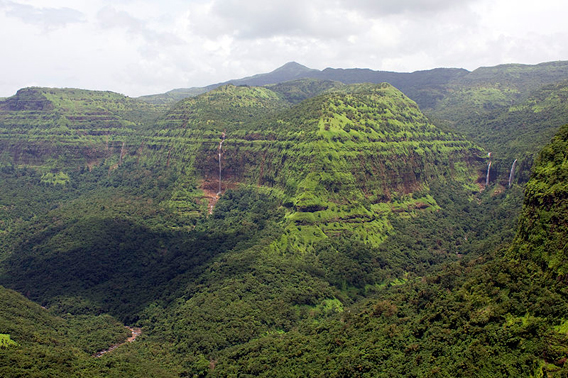
View from Varandha Pass in the Western Ghats.
India’s Western Ghats, considered one of the richest biodiversity hotspots in the world, has been dubbed a UNESCO World Heritage Site. In total, 39 different sites in the tropical rainforest—home to Asian elephants, Bengal tigers, lion-tailed macaques, and thousands of other species—have made it under the listing.
“We welcome these sites to the World Heritage List, but note the conservation challenges that they face will need additional monitoring by the World Heritage committee to ensure that these sites meet the requirements that accompany this listing as flagships for global conservation,” the director of the International Union for Conservation of Nature (IUCN), Tim Badman, said. The IUCN recommended the Western Ghats, but with a word of caution about conservation management issues in the region.
For thousands of years, the Western Ghats has supported a tenuous balance between agriculture and wildlife. The forest, which is heavily fragmented, remains imperiled by mining, industrial agriculture, ongoing deforestation, poaching, human-wildlife conflict, dams, roads, overpopulation, and even tourism.
The Western Ghats is home to more than 5,000 flowering plants, 139 mammals, over 500 birds, 288 freshwater fish, and 179 amphibians. New species continue to be found in the region.
India had been campaigning for six years to have the Western Ghats enshrined as a World Heritage Site.
Related articles
Photos: 10 new frogs discovered in India’s great rainforest

(08/09/2011) Ten new species of frog have been discovered in India’s Western Ghats according to two new papers in Biosystematica. Although human populations have farmed in the Western Ghats for centuries, the new discoveries prove that the rainforest still holds many surprises. The Western Ghats lie along India’s west coast and have been dubbed one of the world’s biodiversity hotspots, but the rich wildlife is imperiled by rising human impacts.
Balancing agriculture and rainforest biodiversity in India’s Western Ghats

(08/08/2011) When one thinks of the world’s great rainforests the Amazon, Congo, and the tropical forests of Southeast Asia and Indonesia usually come to mind. Rarely does India—home to over a billion people—make an appearance. But along India’s west coast lies one of the world’s great tropical forests and biodiversity hotspots, the Western Ghats. However it’s not just the explosion of life one finds in the Western Ghats that make it notable, it’s also the forest’s long—and ongoing—relationship to humans, lots of humans. Unlike many of the world’s other great rainforests, the Western Ghats has long been a region of agriculture. This is one place in the world where elephants walk through tea fields and tigers migrate across betel nut plantations. While wildlife has survived alongside humans for centuries in the region, continuing development, population growth and intensification of agriculture are putting increased pressure on this always-precarious relationship. In a recent paper in Biological Conservation, four researchers examine how well agricultural landscapes support biodiversity conservation in one of India’s most species-rich landscapes.
Back from a century of extinction, conservation proposed for elusive Asian flying squirrel

(06/27/2011) The Travancore flying squirrel (Petinomys fuscocapillus) occurs in the forests of the Western Ghats and Sri Lanka, a global biodiversity hotspot, and is listed as Near Threatened on the IUCN Red List. During the first half of the 20th century the species was thought to be extinct, but was rediscovered in the 1960s, then not seen again for over twenty years.
Cloud forest dung beetles in India point to ‘fossil ecosystem’
(03/28/2011) In the cloud forests and grasslands of India’s Western Ghats, known as sholas, researchers have for the first time comprehensively studied the inhabiting dung beetle populations. The resulting study in mongabay.com’s open access journal Tropical Conservation Science, has led scientists to hypothesize that the beetles in concordance with the sheep-like mammal, the nilgiri tahr (Nilgiritragus hylocrius), may be a sign of a ‘fossil ecosystem’.
Parks key to saving India’s great mammals from extinction

(02/24/2011) Krithi Karanth grew up amid India’s great mammals—literally. Daughter of conservationist and scientist Dr. Ullas Karanth, she tells mongabay.com that she saw her first wild tigers and leopard at the age of two. Yet, the India Krithi Karanth grew up in may be gone in a century, according to a massive new study by Karanth which looked at the likelihood of extinction for 25 of India’s mammals, including well-known favorites like Bengal tigers and Asian elephants, along with lesser known mammals (at least outside of India) such as the nilgai and the gaur. The study found that given habitat loss over the past century, extinction stalked seven of India’s mammals especially: Asiatic lions, Bengal tigers, wild dogs (also known as dholes), swamp deer, wild buffalo, Nilgiri Tahr, and the gaur. However, increasing support of protected areas and innovative conservation programs outside of parks would be key to saving India’s wildlife in the 21st Century.







